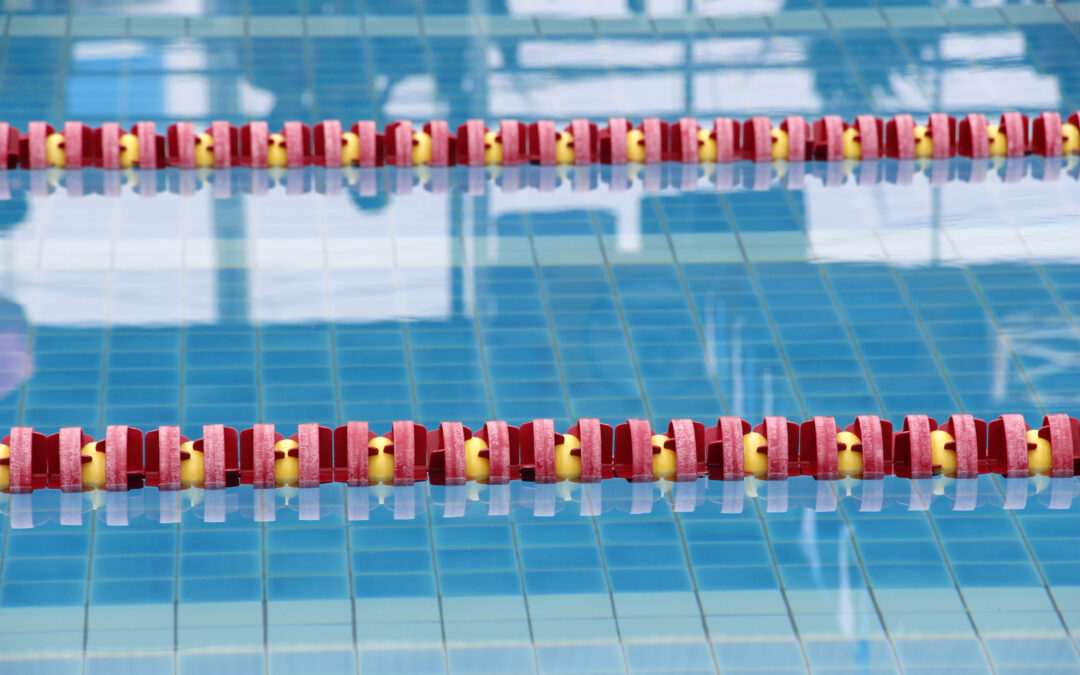Aristotle said, “Those who know, do. Those that understand, teach.” Being an athlete and a coach, I simultaneously wear two hats. I like to think of myself as both student and teacher. Most often, my truest sense of understanding comes through first-hand experience. I tried to maintain this perspective on pool running and rehab in general throughout this long recovery period.
For 8 weeks, rehabbing from a torn plantar, I existed on a pendulous continuum in the water. Determined to keep recovery purposeful, I set two goals. 1: Maintain as much fitness as possible despite the removal of gravity. 2: Learn as much as possible from this adventure.
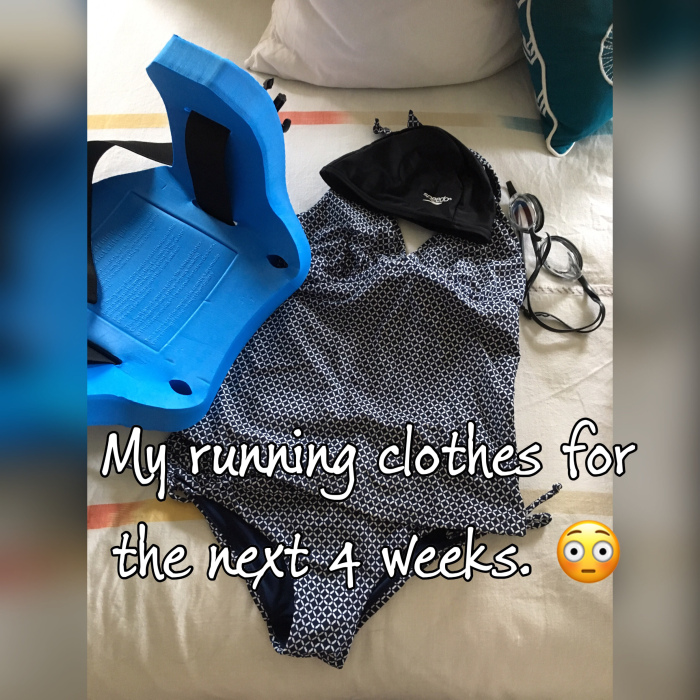
There were just a couple of necessities to start: a pool membership and a belt. The local YMCA is only two miles from home and offers plenty of available lanes throughout the day. I promptly reactivated my account. Next, I needed a buoyancy belt. The YMCA has a few on the pool deck. However, with an extra small body type, I chose to purchase and own to ensure adequate fit. From what I’ve read, you can opt to go without this device, but I decided it was worth the investment since I would be spending 5 days per week in the deep end. I ordered my Aqua-Jogger belt on Amazon; it arrived within two days.
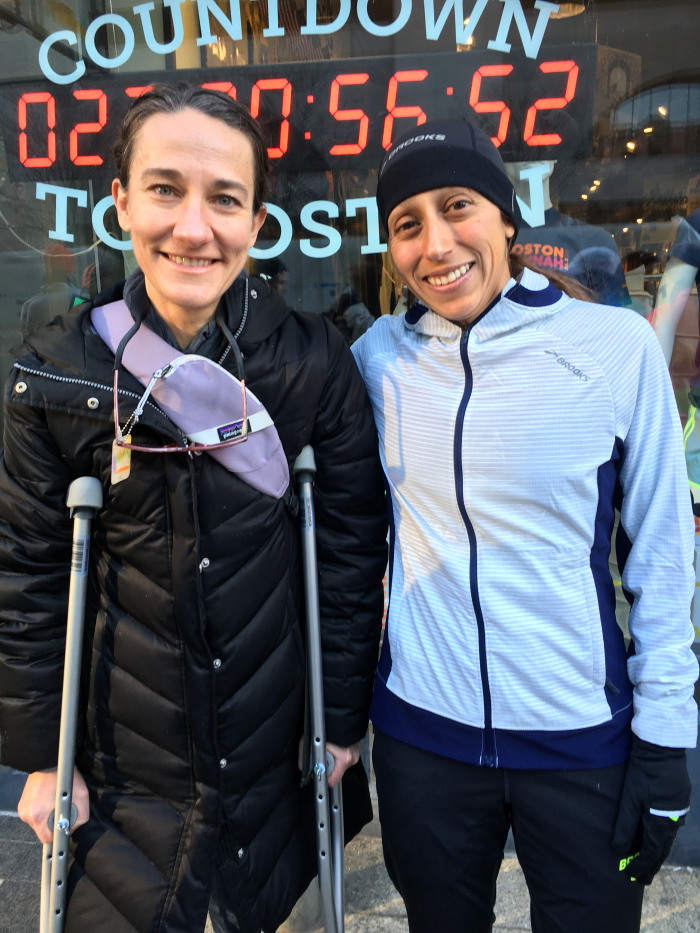
The doctor’s orders were to remain completely non-weight bearing until our next visit. At that time, I had already been living on crutches with all activity suspended for two weeks. While I was given the green light for pool running, this meant at least 4 more weeks on crutches and no toeing off or touching down during workouts.
Coach Braz continued to write programming throughout my recovery. Having never used this mode of cross training, I had no preconceived notions on workout design or duration. An eager student anticipating my first weekly assignments, I prepped as best I could by reading blogs and watching videos on the topics of form and technique. Here I learned about alignment and ways to cue myself while in the water.
Like an enthusiastic school girl, I packed my bag: towel, swim cap, and goggles (just in case), water, Oofos slides, dry underclothes (wearing my bathing suit upon arrival), lock, and aqua belt. I was ready to go.
Bumps in the “road’ to the water (an aside):
Optimism fizzled fast, as I faced a few logistical obstacles in week one. Not yet familiar with the ebbs and flows of attendance, I arrived during peak hours. It was March in Massachusetts: windy, grey, and cold. The only available parking was in the side lot, which presented a long and challenging walk to and from the facility on crutches.
At the lobby, I fumbled with my fob for the scanner. Nothing is smooth on crutches. I tried to revive my spirit as I hobbled toward the locker room. However, a few more physical obstacles stood between me and the pool: doors. The doors to the locker rooms were surprisingly heavy. I never noticed that before. There are 4 in all, and I had to open each of them twice. With a yank and a protective crutch as a doorstop, I passed the first two. Now inside, I peeled my layers, slipped on my flops, donned my backpack, and moved toward the next set of doors. This time there was a bonus challenge: wet floors. Carefully, I made my way along the wet tile to the bleachers. Luckily, I found an open lane and dropped my belt and water bottle at the block. All in all, by the time I reached the pool deck, I was feeling discouraged.
The room was warm and humid. Through the massive windows, I saw the trees bend in the wind against the bleak sky. For a moment, I was thankful to escape the ugliness of the cold and raw early spring. It was time for a break from the crutches and my negative attitude; the water promised both.
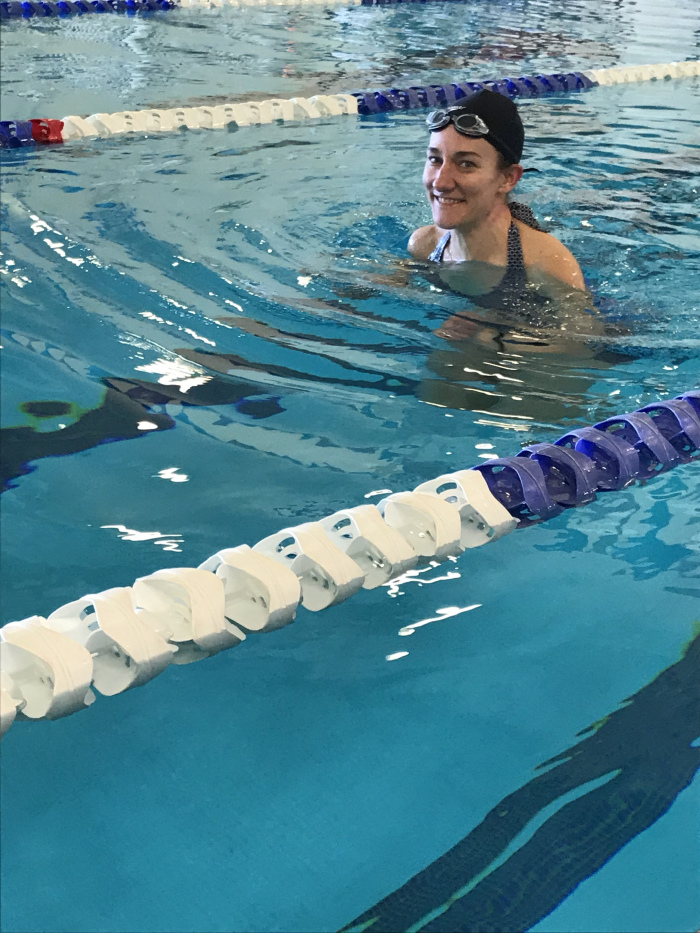
Form and feel:
If you have never experienced pool running, you might think it is as simple as staying afloat and engaging perpetual forward motion much as you would on the pavement. However, this is not the case. To maximize the benefits of this workout, I needed to engage in proprioceptive mindfulness.
Proprioception is an awareness of one’s body position in space. Pool running, done well, requires a keen sense of positioning. Some physical cues from land transfer to the water. Others, I learned, are novel and specific to the pool.
With a tug and a click, I fastened my belt to allow for a snug fit with the hump facing up for back support. The belt should be cinched so that it has no wiggle room on dry land. This prevents the device from riding up and interfering with arm swing once in the water. Using the block for stability, I lowered myself to a seated position and eased into the temperate pool. Afloat with head and shoulders just out of the water, I emulated a running motion.

Somewhere between moving through Jell-O and doing a marathon of mountain climbers lies the kinesiology of pool running. To elicit this sensation, I follow a somatic script:
ALIGNMENT/CORE: Thinking tall, I engage my core to create neutral alignment from head to toe. I lean a little, from my ankles, just as I would on land. The muscles of my abs and back work in conjunction to avoid a break at the waist or a face planted in the water.
ARMS/SHOULDERS: My arms, held at a 90-degree angle from the elbows, swing from the shoulder joints. However, it takes more effort to pump due to the resistance of the water. My goal is a generous arm swing, front to back, where hands arrive to barely break the surface of the water before a drive backward which brings hands to hips and triceps close to kissing the surface on the opposite end of the swing. This action, with the added resistance, offers a bonus strength workout for my arms and shoulders.
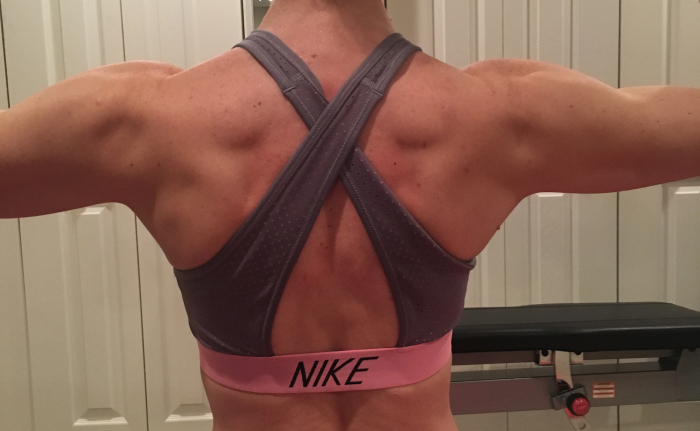
LEGS/HIPS: Under the water, my legs are always moving. This is where it is important to understand the distinctions between the gait cycle on land and in water. In the water, I think about marching form. I drive my knee to 90-degrees and maintain a neutral foot position. At the top of that angle, instead of reaching out with my leg/foot, I stomp downward toward the pool floor. My legs continuously move through the cycle for the duration of the workout. Again, the added resistance of the water as I drive my knees introduces a strength component to these sessions.
Opting to roam, I chose not to be anchored or tethered to the side of the pool. Unlike outside, it was amusing to find how slowly I drifted down the lane despite the acceleration of my limbs. Speed was not a factor. Distance traveled was not altered by the varied “paces.” Nevertheless, my heart rate, resistance to lactic acid, and fatigue levels were tapped and tested by effort based intervals.
Monitoring pace and effort:
Sessions in the water lasted anywhere from 60 mins to 105 minutes. When I compared minutes in the pool to mileage on land prior to injury, the duration was equitable. There was comfort in knowing that Coach Braz was programming for a similar workload. Tempos were a mix of easy, steady (marathon pace effort), threshold (10k race effort), and hard (5k race pace or faster). Intervals lasted anywhere from 30 seconds to 10 minutes depending on the effort level and purpose of the workout.
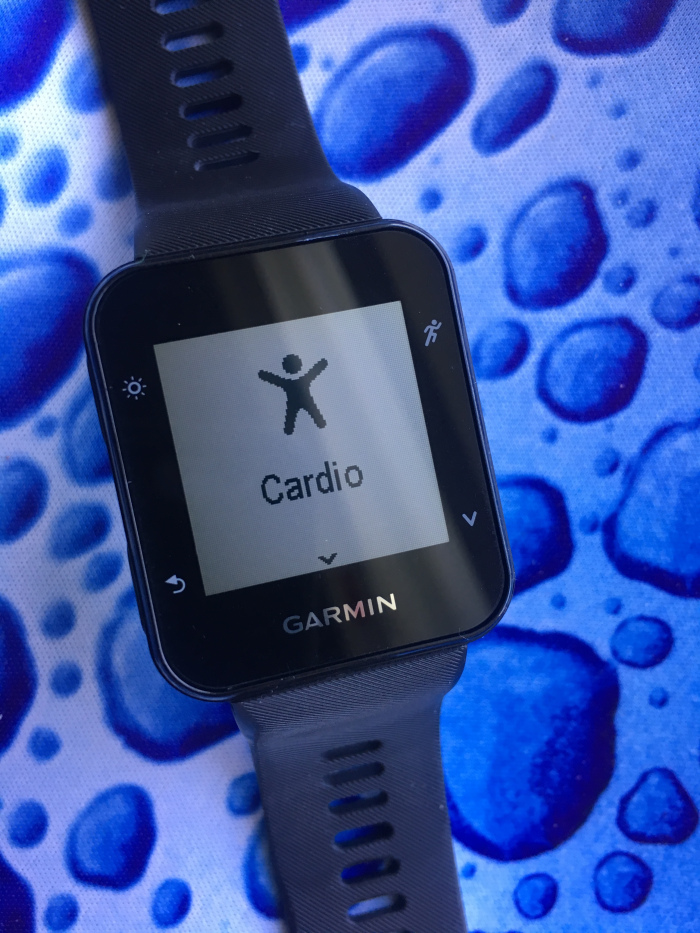
Since I was not swimming, progress monitoring needed to be adapted. Garmin lap data was not going to adequately record these workouts. Instead, I used levels of perceived effort and a not-so-accurate wrist-based heart rate monitor in my watch. Given this, the cardio setting seemed the best option. It displayed total time, which allowed interval tracking, as well as “heart rate-ish” zones. Every so often, I took my carotid pulse, as well. Albeit imprecise, it was better than nothing.
In pool running, “speed” and cardiovascular zones are fluxed by the swing tempo of legs and arms. Want to know what this feels like? Allow me to paint you a picture: Strap some weights to your wrists and ankles. Now, drive your knees and elbows. Stay tall and RUN FAST. Welcome to intervals in the pool. Of course, it is not all at that effort. Just as with other training, intervals are one piece of the workout puzzle. Still, the faster I drive my arms and legs, the more resistance I encounter in the water. This, in turn, drives up heart rate, quickens breathing, and introduces lactic acid, which ultimately causes fatigue. After all, fitness is built through the introduction of challenging stimuli followed by adaptation.
To achieve varied effort levels, the cadence of my arms and legs increased while maintaining proper form as described earlier. I liken it to running through mud. To ensure consistency, I counted my cadence and replicated that number during future intervals. In other words, if I reached 95 steps with my right foot in a hard 60-sec interval, then I would continue to shoot for that number in the remaining 60-sec intervals on that day.

All in all, most days were chunked into such tempo changes, which also broke up the monotony of going nowhere fast. This design got me through hours in the pool just as it had miles on the road.
One undesirable side-effect to note was chlorine inhalation. Five days a week, huffing at the surface for an hour or more brought some strange symptoms. At times, the chemical scent permeated my nostrils and skin and saturated my hair so that it seemed permanent. My lungs felt, for lack of a better term, water-logged. It was a sensation of not being able to get a complete deep breath. An occasional symptom, not a constant, I let it go knowing that the setting was temporary.
Transitions and Transference:
If you really want to know a place, then live there for a while. Suspended in an alien climate for two months, water afforded independent mobility when I needed assistance in all else.
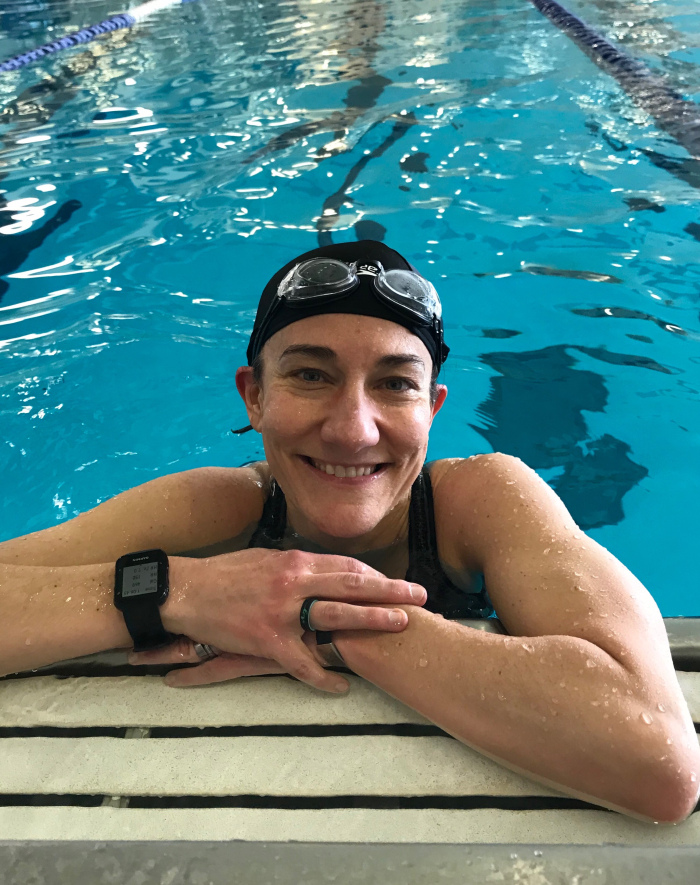
I began in March with two goals: maintain fitness and learn from my adventure. All things considered, I have checked both boxes. Transitioning off of crutches, I eased into the shallows. I ran past the usual hairpin turn that kept me safely in deep waters. Decreased buoyancy meant increased impact. The time had come to trust in my healing capacity. With a cautious cadence, I gently touched down and pushed off of the pool tiles – a sign of forward progress. At week 8, I was cleared to transition to some biking as well as running on the Alter-G treadmill. (Coming soon: A follow-up post on this peculiar apparatus.)
On reflection, these hours in the pool have paid off. It is impossible to maintain all run specific fitness without actually running. On land, I fight gravity and recruit my legs and feet in forwarding propulsion. Water cannot precisely replicate these properties. Still, there are many relevant and transferable elements.
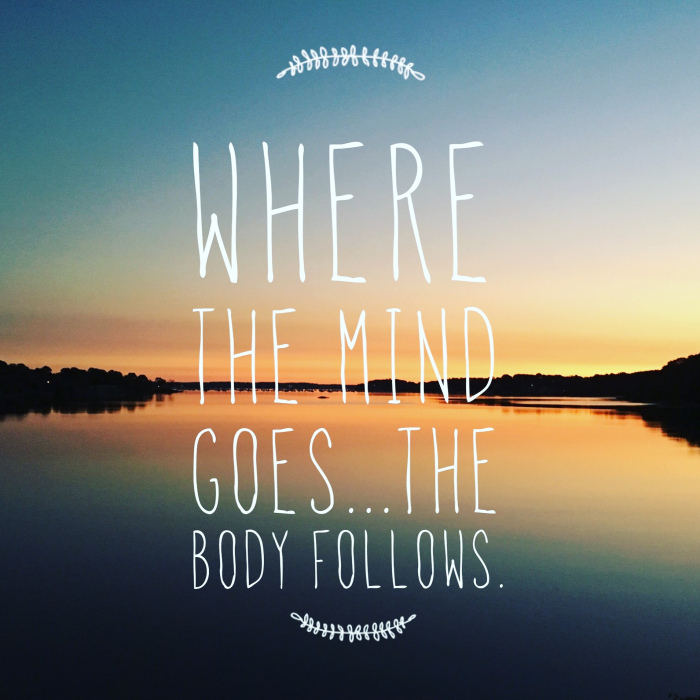
Going the distance in the pool meant putting in the time, whether I felt like it or not. Mental endurance and will power were significant factors in past successes on the road. Much like any muscle, they needed to be exercised during my recovery period. Pool running accomplished that objective.
Interval training taxed my cardiovascular system and muscular endurance. Much of this base is tied to longevity. Without pool running, I would have sacrificed consistency and suffered a more significant loss in that fitness foundation.
Floating in the pool, similar to running on the road, allowed my mind to drift in tandem with soothing motion. When I hit roadblocks in writing or elsewhere, running brings relief. The pool has been no different.
Honestly, my favorite takeaway is perhaps not my fitness, but the simple acts of kindness I received from strangers. An offer to help, a kind word, a door held, a volunteer to share a lane – these small but selfless gestures brought much needed joy when my resilience was threadbare.

The warmth of spring’s end has arrived; with it, a heightened craving for the road. Soon, the perfume of chlorine will be traded for the scent of sunscreen and sweat. While this transitory period was prompted by an eviction, one thing remains: I wouldn’t be at this healthy junction if it weren’t for my time in the pool. For that, I am eternally grateful.
#keepshowingup

